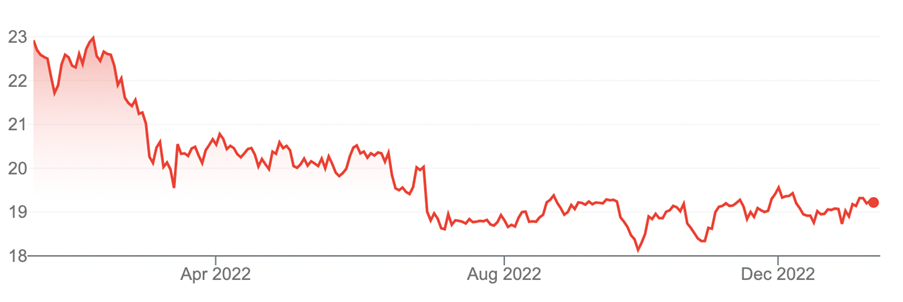Contrarians seeking exposure to beaten-up assets have much choice in 2023. From Bitcoin to bonds, asset prices tumbled last year as inflation and interest rates climbed.
Emerging markets plunged. The MSCI Emerging Markets Index (US dollar), a barometer of 1,377 stocks across 24 emerging-market countries, lost 20% in 2022.
By October 2022, the index was down 41% from its February 2021 peak, reinforcing that emerging markets (EMs) can be a rollercoaster ride in the short run.
Nothing went right for emerging markets. China’s woes last year cascaded across emerging market regions. China is a major trading partner for many developing countries and Chinese equities have a high weighting in benchmark emerging market indices.
China’s previous zero-COVID policy, property-sector problems and regulatory crackdown on tech and other sectors hurt its economy.
Then there was US-dollar strength. As US interest rates rose to tame inflation, the US dollar rallied. A stronger dollar raises the cost of US-dollar debt and imports for emerging markets. Over the years, a high US dollar has sparked emerging market crises.
Together, China’s problems and US-dollar strength triggered an exodus from emerging market assets last year. Institutional investors slashed their portfolio allocations to emerging markets, making them badly unloved and under-owned.
But every asset has its price. On several measures, emerging market indices are historically cheap compared to developed markets after being dumped last year.
Emerging markets traded at a 35% discount to developed markets on a Price Earnings (PE) basis at the end of November 2022, analysis by Lazard, an asset manager, shows.
On a price-to-book basis, that discount was 44%. The analysis compares aggregate valuations in the MSCI Emerging Markets Index to the MSCI World Index.
Emerging markets should trade at a hefty discount because they are more volatile. But the discounts at end-November 2022 were among the largest in two decades, suggesting emerging market equities were oversold.
By late 2022, several investment banks argued that emerging markets were poised for a comeback this year. I’ve heard similar arguments from asset managers over the years, usually those that have emerging market investment funds to promote.
Care is needed. In the past 10 years, the MSCI Emerging Markets Index had negative returns in six years. In some years, heavy double-digit losses featured.
Clearly, this is an asset for experienced investors with higher risk tolerance and a long-term focus (at least 5-7 years, preferably longer).
For most investors, emerging markets should only have a small allocation (5% or less) in the international equities component of their portfolio. Conservative income investors, such as retirees, should avoid emerging markets given the risks involved.
The US dollar is another caveat. If you believe the US Federal Reserve will contain inflation this year, prompting a slowdown in rate rises and eventual rate cuts, emerging markets look interesting. A retreating US dollar would be a tailwind.
Conversely, investors who believe the world is heading for a hard economic landing in 2023 – and a severe recession in many countries – should avoid emerging market equities. In that scenario, emerging markets will get cheaper yet.
Investors who buy emerging markets today are taking significant risk because the inflation-rate/US-dollar outlook is still uncertain. More commentators are predicting a weaker Greenback in 2023, which in itself should be cause for hesitation.
Nobody makes money investing with the crowd and I wouldn’t underestimate the US dollar in 2023 given its enduring status as the world’s reserve currency.
Still, if you wait for a lot more clarity, emerging markets won’t be as cheap anymore.
Reasons for cautious optimism
For growth-focused investors, five factors support a modest portfolio allocation to emerging markets in 2023 as a contrarian play.
The first is valuations. Emerging markets have done nothing for a decade. The MSCI Emerging Markets Index returned 1.44% annually over 10 years to end-December 2022. The MSCI World Index returned 8.85% during that period.
The best form of risk management is buying assets when they trade well below their intrinsic value and offer a decent margin of safety.
Emerging markets might fall further in 2023, but a huge amount of future bad news is already priced into valuations. An average forward PE of 11 on the MSCI Emerging Markets Index (at end-December 2022) compares to 15 for the MSCI World Index.
The second factor is China. The end of its zero-COVID policy is good news for China’s economy and its EM trading partners in 2023. Sadly, COVID-19 infections and deaths are climbing in China. But the end of its zero-COVID policy – and signs of a COVID exit – remove an uncertainty for markets.
A weaker US dollar is the third factor. Yes, trying to predict currency moves is a mug’s game. But signs are growing that US inflation is cooling and that interest rates there are closer to peaking. As I wrote last year for this report, I expect US-dollar strength to ease in 2023. That will good news for EMs that borrow in US dollars.
The fourth factor is commodities. I have a positive view on commodities for 2023, more because of supply constraints than on the demand side (although an improving China economy is good for commodities demand). Emerging markets are collectively commodity exporters, so higher commodity prices aid those markets.
The fifth reason is sentiment. Emerging markets were on the nose last year. Institutional investors ran a mile from the asset as risk aversion grew. Apart from some investment banks talking up emerging markets – and a fourth-quarter rally in the asset class off a low base – there’s still a lot of negativity.
The best time to buy assets is usually when nobody wants to own them or has stopped looking at their prospects. That could be true of emerging markets in 2023.
Index funds
ASX-quoted Exchanged Traded Funds (ETFs) are the easiest way to gain low-cost exposure to emerging markets. The iShares MSCI Emerging Markets ETF (IEM) tracks the world’s most-watched EM index.
Bought and sold like a share, IEM provides instant diversification through a portfolio of 1,231 EM stocks. The annual fee is 0.69%.
Chart 1: iShares MSCI Emerging Markets ETF (AUD)

Source: ASX
The Vanguard FTSE Emerging Markets Shares ETF (VGE)) is another option. VGE tracks the FTSE Emerging Markets All Cap China A Inclusion Index and the 5,575 holdings within it, across developing nations.The median market capitalisation of stocks in VGE was $28.6 billion at end-November 2022. That’s large by Australian standards and provided some comfort that investors are gaining exposure to prominent companies in EM regions (though they, too, can fall sharply when markets tumble).
VGE’s diversification and management fee of 0.48% are other attractions. The ETF suits investors who want low-cost exposure to a wider range of EM equities.
Chart 2: Vanguard FTSE Emerging Markets Shares ETF (VGE)

Source: Google Finance
Active funds
As investment tools, ETFs are useful building blocks for portfolios. But they are designed to provide the index return. For EMs, that means copping heavy negative returns when market volatility spikes – and losses for those who have to sell.
Smart-beta ETFs are an alternative. These ETFs use investment rules to maximise exposure to factors such as growth and value of moment. As such, smart-beta ETFs provide a simplified, automated form of active management, without the fees of active funds.
The VanEck MSCI Multifactor Emerging Markets Equity ETF (EMKT) provides smart-beta exposure to this asset class. EMKT aims to maximise exposure to EM equities on four factors: Value, Momentum, Low Size and Quality.
EMKT has had better relative performance than EM index ETFs over one year to end-December 2022. But EMKT’s smart-beta approach, focus on smaller companies and fewer stock holdings (231) gives it a higher risk profile than broad-based EM ETFs.
After a brutal sell-off in small-cap equities in EMs, the average PE multiple in EMKT was 5.8 times (over 12 months). The trailing dividend yield was 7.8%. EM speculators will find appeal in small caps in the region.
Chart 3: VanEck MSCI Multifactor Emerging Markets Equity ETF (EMKT)

Source: Google Finance
Among active ETFs, the Fidelity Global Emerging Markets Fund (FEMX) suits investors who want full active management in EMs. That means having fund managers who specialise in the region and decide what and when to buy and sell.
FEMX has a concentrated portfolio of 30-50 stocks. An annual fee of 1% is higher than index funds and reflects FEMX’s active management.
FEMX returned -18% over one year to end-December 2022. Fidelity has a good reputation in EMs: FEMX has outperformed its benchmark index since the fund’s inception in late 2013.
Chart 4: Fidelity Global Emerging Markets Fund (ASX: FEMX)

Source: InvestSmart
Tony Featherstone is a former managing editor of BRW, Shares and Personal Investor magazines. The information in this article should not be considered personal advice. It has been prepared without considering your objectives, financial situation or needs. Before acting on information in this article consider its appropriateness and accuracy, regarding your objectives, financial situation and needs. Do further research of your own and/or seek personal financial advice from a licensed adviser before making any financial or investment decisions based on this article. All prices and analysis at January 18, 2023

